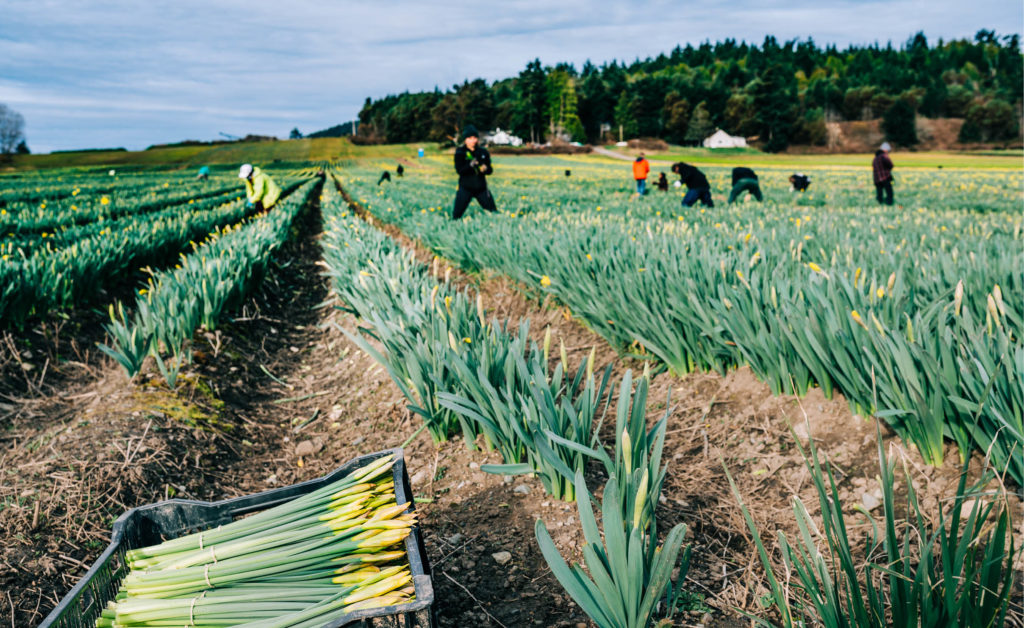by Deborah Rogers | Photos by Janis Jean Photography –
If you want to see the story behind the thousands of cheerful yellow blooms we find in our stores from February to April, you have to get up early. My visit to Longview Farms in Central Saanich started at 7 a.m. and there were already plenty of people going about their working day.
Each season between three and five million blooms are sent out from this warehouse, all grown in the soil of the Saanich Peninsula. That’s something to feel very Peninsula-proud of! They are shipped down to the states and distributed through the Pacific Northwest and of course they are sold all over the Island too. The 2021 season will see less blooms shipped, probably around two to three million. That’s due to a shortage of pickers who usually come from Mexico, and from other parts of Canada; our late February snow didn’t help either!
The daffodil day doesn’t actually start in the field; it starts in the warehouse where the previous day’s pickings are sorted, quality controlled and set in buckets of water in the cold rooms. The stems are picked with the flower closed, and they can actually sit in cold (0°C) water for up to a month. This allows a large number of flowers to be shipped at a time. The cold store I looked into was absolutely packed with bucket after bucket of daffodils which were shortly to be shipped to one of Longview’s largest customers. A wholesaler in the states takes a truck with one million flowers at a time and distributes them. Emily, Head Grower, and my guide for the morning, explains how it’s always a bit fraught in the days leading up to the big shipment with some long hours required, and there’s usually a pizza party or similar for the workers to celebrate the achievement when the shipment has gone.
The warehouse staff are separate from the pickers this year due to the need for Covid safety. There is a permanent crew who work year round for Longview with their jobs shifting with the growing season. Even in March there are a few vegetables being processed, and of course much seeding happening in the greenhouses ready for a long season of veggie growing.
To be a daffodil picker is both unskilled labour and yet a job that requires very specific abilities. It’s physically taxing to stand and bend all day long, yet it’s not heavy work. It requires an efficiency of movement, and the ability to settle into a rhythm.
Seasonal pickers register on a day-by-day basis. Currently that process starts with Covid screening, then some paperwork. Returnees are quickly sent up to the field to start their work day, while first timers have an introduction and orientation.
Out in the field there’s a crew manager keeping an eye on proceedings and ensuring any problems are dealt with quickly. But really, daffodil picking is a quiet solitary activity. The plants stretch out before them in straight rows and the job requires a steady move up the rows, selecting and slicing off each bloom that is the correct height and just fully budded enough, but not actually open. The pickers have a stash of elastics and bunch together 10 flowers at time. These are popped down on the soil between rows, and then gathered up on the return trip, 100 bunches per box. Pay is calculated on a per box basis. Like any piece work, there are rewards for working smoothly, efficiently and for the full work day. The pickers are such an important part of the Longview Farms daffodil operation; some of the fastest can pick 10 to 12 boxes in a day!
All the daffodils grown at Longview are of the yellow trumpet type, but there are multiple varieties which ensures the season lasts from February to April. Carenza is the easiest to harvest as they space well. The beautiful blooms that I see on my visit have come from bulbs that have been in the ground for two to three seasons. That’s the side of the operation I hadn’t really considered. The daffodils in my garden at home just come back every year and I never pay them too much attention, but for commercial growers there’s a need to pull the bulbs up every few years. That happens in early summer, using a machine similar to a potato harvester. The bulbs are graded and sized and only the healthiest are kept. Before they are replanted they are heated and then dipped in hot water and a fungicide, dried, and then planted out again in September. It’s a huge job, but if it doesn’t happen every few years the bulbs start to fade and the yield becomes patchy. At Longview there are currently five daffodil fields, with around six million bulbs per field!
Wordsworth wrote that when on his couch “in pensive mood” the reminiscence of a “host of golden daffodils” would lift him and fill his heart with pleasure. It’s an enduring feeling. For me it isn’t spring until my kitchen sees its first cheery bunch of yellow daffs in my favourite earthenware jug. They never fail to lift my heart, and now I know all the work that goes into getting them to me, I’ll appreciate them even more.




